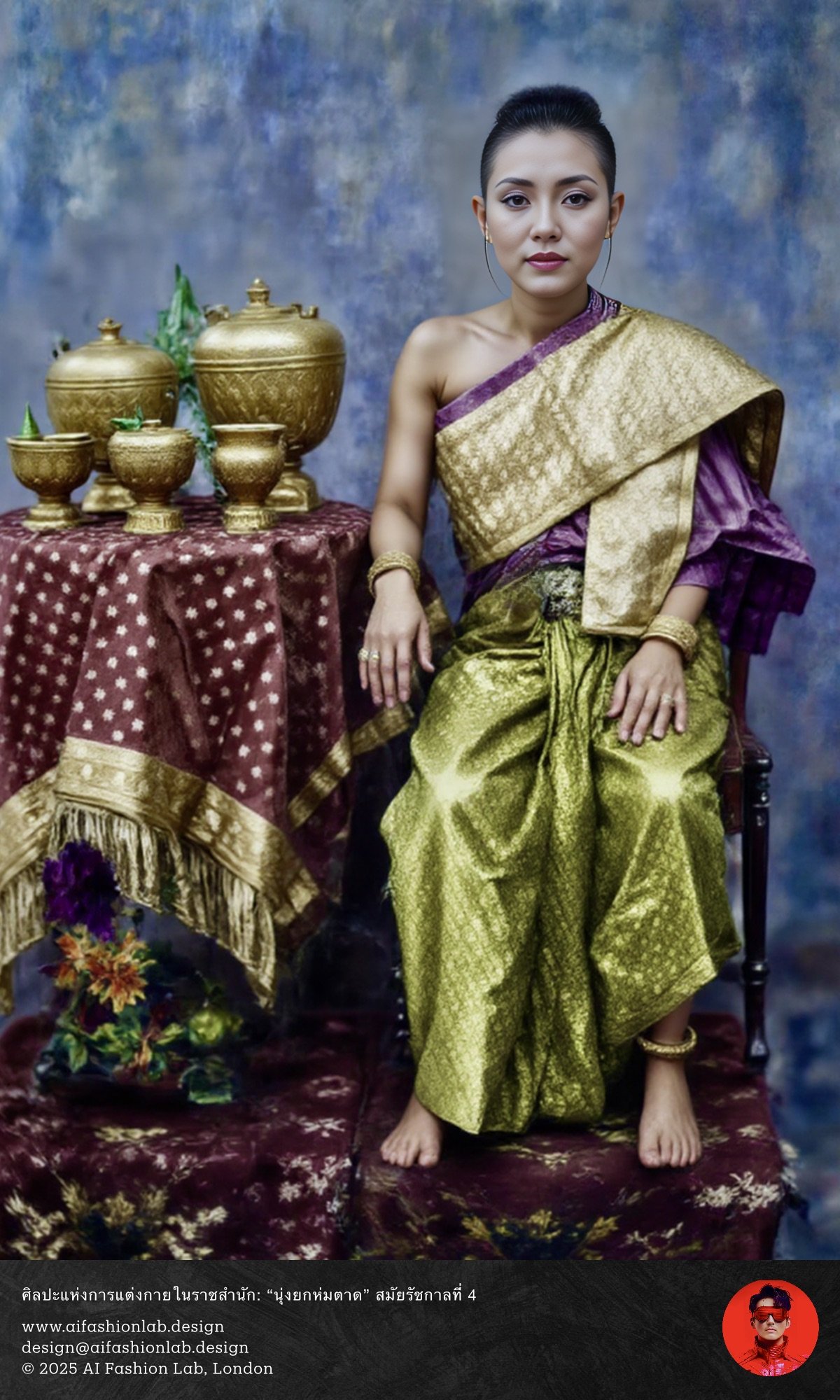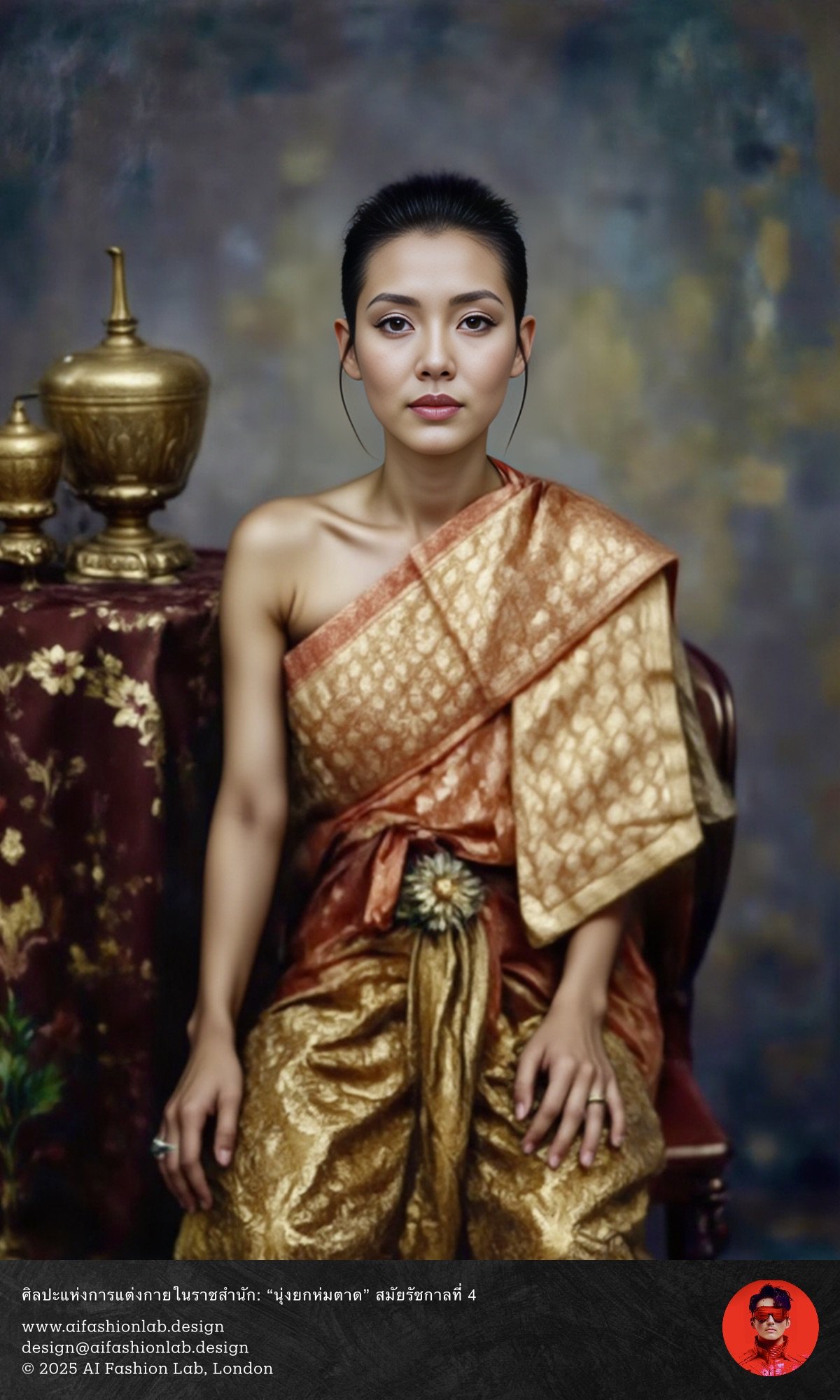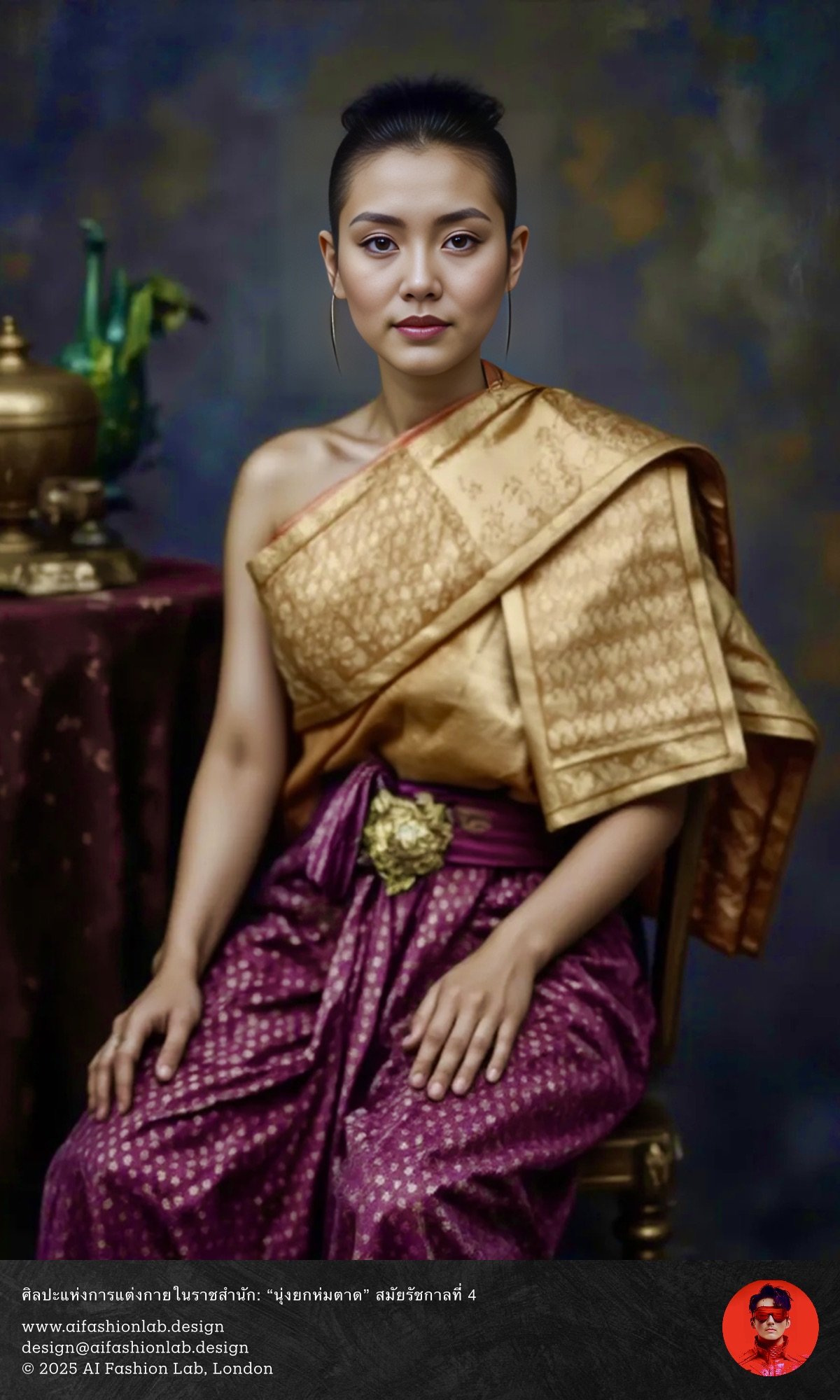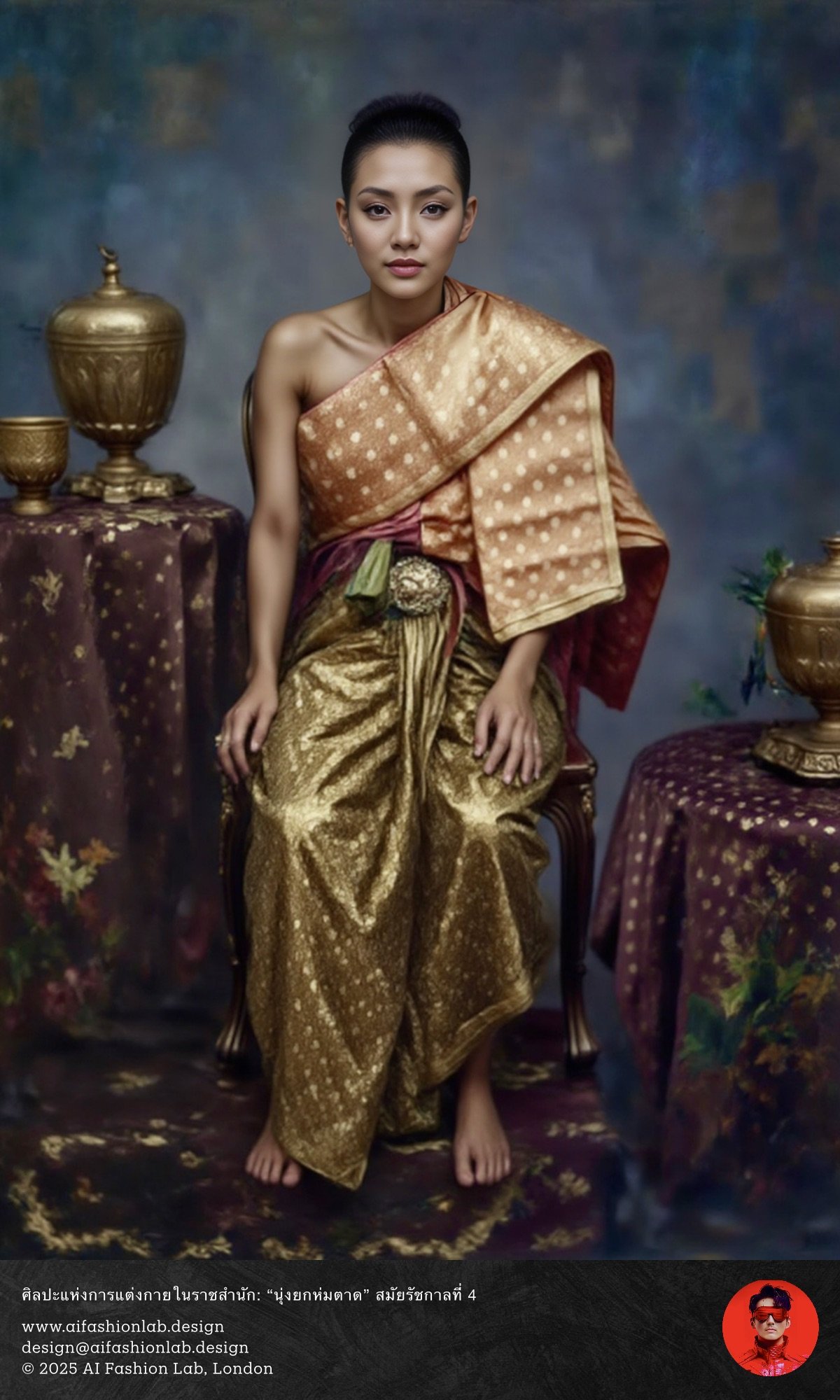The Art of Courtly Attire: “Nung Yok Hom Tad” in the Reign of King Rama IV
In courtly life, clothing choices were carefully guided by auspicious colours and timings aligned with the days of the week, reflecting a deep adherence to ancient Thai traditions. This was not merely a matter of "wearing" clothing but rather an art of "draping" garments with precision and care. For formal occasions, such as royal ceremonies or hosting distinguished guests, the dress style known as “Nung Yok Hom Tad” was customary.
The Art of Courtly Attire: “Nung Yok Hom Tad” in the Reign of King Rama IV
The attire of women in the royal court during the early Rattanakosin period was an exquisite art form, seamlessly blending elegance with symbolic meaning. Court ladies often adorned themselves with brocade silk or gold-patterned fabrics, meticulously crafted with intricate designs by master artisans. These were complemented by diagonal silk shawls made from embroidered or satin fabrics, expertly folded to create pleats of refined beauty. Hairstyles were styled short on all sides of the head, with a distinctive tuft-like crown at the top and long, flowing, soft strands extending gracefully from the sideburns, further enhancing their delicate and sophisticated appearance. This meticulous attention to detail in dress and grooming went far beyond mere fashion—it served as a powerful symbol of status, grace, and appropriateness for various ceremonial and courtly occasions.
In courtly life, clothing choices were carefully guided by auspicious colours and timings aligned with the days of the week, reflecting a deep adherence to ancient Thai traditions. This was not merely a matter of "wearing" clothing but rather an art of "draping" garments with precision and care. For formal occasions, such as royal ceremonies or hosting distinguished guests, the dress style known as “Nung Yok Hom Tad” was customary. This style involved draping a brocade cloth, pleated neatly at the front, and layering it with an intricately designed golden shawl, often accompanied by an additional outer fabric known as the saphak. Such attire exemplified the continuity of royal traditions meticulously preserved from the Ayutthaya era. The act of draping the Hom Tad shawl was akin to donning a modern jacket, lending an air of dignity, formality, and respectability to the wearer.
Reimagining the Past Through AI: Reviving Cultural Heritage with Technology
To portray the essence of women’s courtly attire during the reign of King Rama IV, AI technology can vividly recreate the elegance of “Nung Yok Hom Tad”. These depictions would feature women adorned in brocade fabric with front pleats, draped in elaborately embroidered golden shawls. This synthesis of traditional Thai craftsmanship and modern technology breathes life into a historical narrative, showcasing the timeless beauty and cultural depth of Thailand during one of its golden eras.
ศิลปะแห่งการแต่งกายในราชสำนัก: “นุ่งยกห่มตาด” สมัยรัชกาลที่ 4
การแต่งกายของสตรีในราชสำนักช่วงต้นรัตนโกสินทร์ถือเป็นศิลปะแห่งความประณีต สะท้อนถึงวิถีชีวิตที่ผสมผสานความงามและความหมายเชิงสัญลักษณ์ได้อย่างลงตัว สตรีในวังนิยมสวม ผ้ายก หรือ ผ้าลายทอง อันวิจิตร พิถีพิถันในลวดลายที่ทอด้วยฝีมือช่างชั้นสูง พร้อมทั้งห่ม สไบเฉียง ซึ่งตัดเย็บจากผ้าปักหรือผ้าแพร โดยพับให้เรียบร้อยดุจอัดกลีบอย่างงดงาม ผมของสตรีในราชสำนักมักตัดไว้เชิงสั้นเรียบง่ายตามแบบแผน ทั้งหมดนี้สะท้อนถึงการใส่ใจในรายละเอียดของการแต่งกาย ซึ่งเป็นมากกว่าความงาม แต่เป็นการแสดงถึงสถานะ ความสง่างาม และความเหมาะสมตามโอกาส
ในวิถีชีวิตของชาววัง การแต่งกายถูกกำหนดโดย โฉลกสี และฤกษ์มงคลตามกำลังวัน นี่ไม่ใช่เพียงการ “สวมใส่” หากแต่เป็น “การนุ่งห่ม” ที่พิถีพิถันตามคตินิยมไทยมาแต่โบราณ โดยเฉพาะในโอกาสสำคัญ เช่น ราชพิธีหรือการรับแขก การแต่งกายที่เรียกว่า “นุ่งยกห่มตาด” เป็นการนุ่งผ้ายกที่จัดจีบด้านหน้าให้เกิดเป็นกลีบงามอันเรียบร้อย ผสานกับการห่มสไบตาดทองทับด้วยผ้าสะพัก ซึ่งเป็นแบบแผนโบราณราชประเพณีที่ถ่ายทอดจากยุคกรุงศรีอยุธยา โดยการห่มตาดนี้เปรียบเสมือนเสื้อแจ็คเก็ตในยุคปัจจุบัน ที่ช่วยเสริมความสง่างาม สร้างความน่าเลื่อมใส และเหมาะสมกับโอกาสที่เป็นทางการ
การสร้างสรรค์ด้วย AI: ฟื้นอดีตผ่านจินตนาการแห่งเทคโนโลยี
เพื่อนำเสนอภาพลักษณ์ของสตรีในราชสำนักสมัยรัชกาลที่ 4 อย่างสมบูรณ์ เทคโนโลยี AI สามารถช่วยสร้างภาพจำลองที่สะท้อนถึงความงามของการแต่งกายแบบ นุ่งยกห่มตาด ได้อย่างมีชีวิตชีวา ภาพสตรีที่นุ่งผ้ายกจีบด้านหน้า ห่มสไบตาดทองปักลวดลายงดงาม คือการผสานระหว่างความวิจิตรบรรจงของงานหัตถศิลป์ไทยและจินตนาการจากเทคโนโลยี การทดลองนี้ไม่เพียงแต่ช่วยถ่ายทอดความงามที่ยึดโยงกับอดีต แต่ยังช่วยสื่อถึงมรดกวัฒนธรรมที่เปี่ยมไปด้วยความลุ่มลึกและเอกลักษณ์ของไทยในยุครุ่งเรืองของราชอาณาจักร
#aifashionlab #AI #aiartist #aiart #aifashion #aifashiondesign #aifashionstyling #aifashiondesigner #fashion #fashionhistory #historyoffashion #fashionstyling #fashionphotography #digitalfashion #digitalfashiondesign #digitalcostumedesign #digitaldesign #digitalaiart #promptography #promptographer #fashionpromptography #AImodeltraining #AIFashionofThailand












